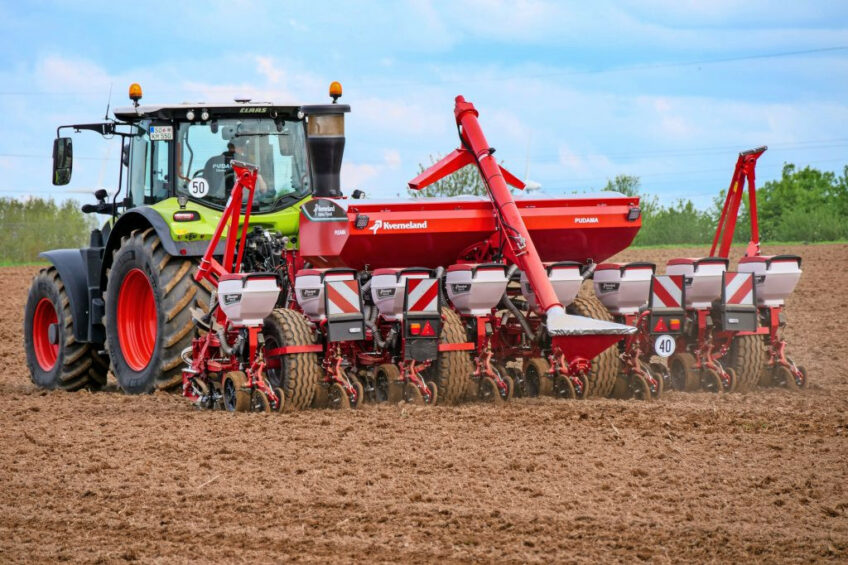Ultra-precise fertilization during sowing: technology ready for both liquid and granular fertilizers

Driven by increasingly stringent fertilization regulations and soaring fertilizer prices, machinery manufacturers are developing solutions to apply fertilizers with greater precision. One such innovation is spot application during sowing: “dots” of fertilizer instead of a long, narrow band. But are farmers interested? And is granular or liquid fertilizer the better choice?
Precision fertilization is the future, according to experts, researchers, and manufacturers discussing the application of starter fertilizers, microgranules, and other granular fertilizers during sowing. Take, for example, Kverneland’s Pudama technique. This stands for PUnktgenaue DüngerApplikation bei der MAisaussaat—or point- or spot application of granular fertilizers during maize (and sugar beet) sowing.
Precise spots
With spot application, starter fertilizer is not applied in a continuous band next to and below the seed but rather in precise spots adjacent to and beneath it. Fertilizer granules are collected and grouped by a conical, funnel-shaped brush, then expelled at the correct moment by a burst of air. According to Kverneland, this approach achieves the same yield with up to 25% less starter fertilizer, freeing up fertilizer for use elsewhere.
The first prototypes were tested in 2019. By 2023, the system was available on a limited basis, with broader availability expected in 2024. Currently, four systems are operational in Germany for maize. These systems are mounted on pulled Optima TF Profi SX seeders, and the technology is also available for other Optima models. The Pudama system costs €17,450 on an eight-row maize seeder.

Amazone introduces FertiSpot
Competitor Amazone has been working on FertiSpot since 2019 and introduced it last fall at the Agritechnica trade fair for Precea seeders. Due to Kverneland’s patent on Pudama, Amazone developed a different technique. A so-called portioning blade spins rapidly to collect fertilizer granules, releasing them at the right moment next to or between the seeds.
Amazone also claims a 25% reduction in starter fertilizer use when sowing maize and sugar beet. For sugar beet, grouping the granules between the seeds is designed to prevent seed burn caused by the fertilizer.
FertiSpot is now widely available for Precea seeders and can also be retrofitted. The additional cost for a new eight-row seeder is €8,000 ex-factory.

Monosem is also developing spot application
Monosem is working on a technique to dose starter fertilizers and microgranules in grouped portions. Details on how it works, when it will be launched, and the potential savings are not yet available. However, Monosem has announced plans to introduce spot application for liquid starter fertilizers in 2025.
Granular or liquid fertilizer application?
This raises the question of whether precise placement of granular fertilizers is necessary and whether it is relevant in the Netherlands. Beyond its borders, liquid fertilizers dominate, especially in the United States. There, systems such as CapstanAG SelectShot, Precision Planting FurrowJet, Great Plains AccuShot, and John Deere’s newly launched ExactShot (in 2024) are widely used. These systems deliver a “shot” of liquid (starter) fertilizer next to, between, or on the seeds.
“Some countries, like the Netherlands, are really granular fertilizer countries,” says Rick de Groot, Product Manager for Sprayers and Precision Seeders at Kverneland Group. “Starter fertilizers and/or granules are always applied during sowing, and you can combine granules with different fertilizers (blends). At the same time, we see a growing interest in liquid starter fertilizers like Entec. These can technically be applied in spots, but so far, this is done in continuous bands during sowing.”
Erwin Tessers, Business Unit Manager at Amazone, questions the benefits of granular spot application for contractors. “If the maize grower already has the fertilizer, the contractor does not save anything. The contractor makes the investment but typically sees no additional income. In that case, I would suggest that contractors handle the supply, logistics, and application of liquid fertilizer. This way, they maintain control and generate revenue.”
“If I were a contractor, I’d prefer to apply liquid fertilizer,” agrees Chris van de Lindeloof, Product Manager at Farmstore. “It’s the most efficient in terms of logistics and effectiveness, and contractors are independent of their customers. Plus, liquid fertilizer is not affected by humidity, as granular fertilizer is. Granular fertilizers are, however, slightly cheaper, and liquid fertilizers require a front tank.” Ultimately, the choice between granular and liquid fertilizers is strongly influenced by advisors, consultants, and the results farmers achieve.



